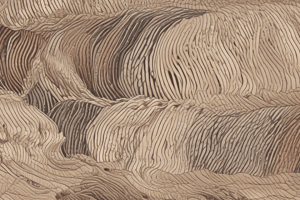Podcast
Questions and Answers
Cotton is an example of a synthetic fiber.
Cotton is an example of a synthetic fiber.
False (B)
Natural plant fibers are not biodegradable.
Natural plant fibers are not biodegradable.
False (B)
Raffia and sisal are examples of natural plant fibers derived from leaf veins.
Raffia and sisal are examples of natural plant fibers derived from leaf veins.
True (A)
Plant fibers from fruits, like coconut fibers, are not widely used in the textile industry.
Plant fibers from fruits, like coconut fibers, are not widely used in the textile industry.
The textile industry's interest in sustainable plant fibers is declining.
The textile industry's interest in sustainable plant fibers is declining.
The production of clothing and upholstery does not rely on textile fibers.
The production of clothing and upholstery does not rely on textile fibers.
Retting is a process used to extract fiber strands from plant tissues that involves breaking down the plant's natural gum.
Retting is a process used to extract fiber strands from plant tissues that involves breaking down the plant's natural gum.
Artificial fibers like nylon, polyester, and acrylic are produced using synthetic polymers.
Artificial fibers like nylon, polyester, and acrylic are produced using synthetic polymers.
Understanding the properties and characteristics of textile fibers is essential for selecting appropriate fibers for specific applications.
Understanding the properties and characteristics of textile fibers is essential for selecting appropriate fibers for specific applications.
Synthetic fibers possess better thermal recovery and thermal conductivity than natural fibers.
Synthetic fibers possess better thermal recovery and thermal conductivity than natural fibers.
The choice of textile fiber can significantly impact the environmental sustainability of the final product.
The choice of textile fiber can significantly impact the environmental sustainability of the final product.
Synthetic fibers are preferred over natural fibers due to their superior moisture absorption and breathability.
Synthetic fibers are preferred over natural fibers due to their superior moisture absorption and breathability.
Flashcards are hidden until you start studying
Study Notes
Textile Fibers
Textile fibers are the fundamental building blocks of the textile industry, which is responsible for the production of clothing, upholstery, and various industrial uses. These fibers come from a variety of sources, including plants, animals, and synthetic materials. They have a long history of use, dating back to 9000 B.C., and have played a significant role in the development of human civilization. In recent years, there has been a growing interest in sustainable and eco-friendly textile fibers due to concerns about the environmental impact of the textile industry.
Natural Plant Fibers
Natural plant fibers are derived from the cellulose found in the cell walls of plants. These fibers have a long history of use in textiles, paper, and technical applications in composite materials. They are biodegradable and sustainable, as they can be returned to the soil without harm and sometimes with beneficial effects, such as hemp. Examples of natural plant fibers include cotton, flax, hemp, and jute.
Types of Plant Fiber
There are four main types of plant fiber: fibers from seeds (e.g., cotton), fibers from stems (e.g., flax, hemp, jute), fibers from leaf veins (e.g., raffia, sisal), and fibers from fruits (e.g., coconut). Among these, cotton is the most widely used.
Sustainable Plant Fibers
The increasing availability of alternative plant-based fibers offers sustainable options for textile products. These fibers can be processed to extract the fiber strands from other plant tissues, often through a process called retting, which involves breaking down the natural gum binding the fibers together. Some of these processes can be natural and organic, while others may require the use of chemicals.
Synthetic Fibers
Synthetic fibers are produced through human intervention using chemical processes. They can be divided into two categories: artificial fibers, such as rayon, which are derived from natural polymers, and synthetic fibers, such as nylon, polyester, and acrylic, which are produced using synthetic polymers. Synthetic fibers are known for their lightweight nature, durability, and resistance to water infiltration, but they lack the natural properties of plant-based fibers, such as breathability and moisture absorption.
Importance of Knowing Textile Fibers
Understanding the properties and characteristics of textile fibers is crucial for the selection of appropriate fibers for specific applications. Natural fibers may have thermal recovery and thermal conductivity, while synthetic fibers may be lightweight and resistant to water infiltration. The choice of fiber can also impact the comfort and performance of textiles, as well as their environmental impact.
In conclusion, textile fibers are a diverse and essential component of the textile industry. Choosing the right fiber for a specific application depends on the desired properties, environmental considerations, and the balance between sustainability and performance. With the growing interest in sustainable materials, the use of natural and alternative plant-based fibers is expected to continue to increase in the future.
Studying That Suits You
Use AI to generate personalized quizzes and flashcards to suit your learning preferences.




